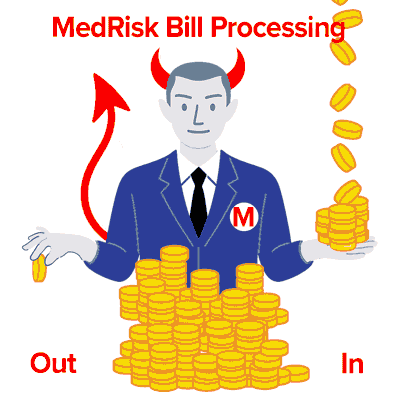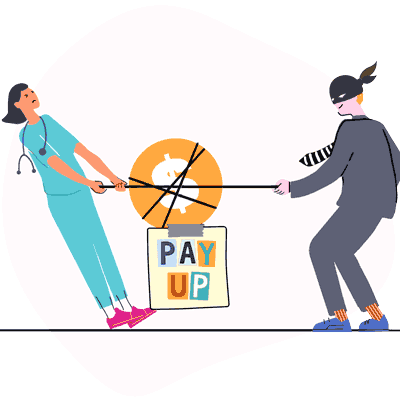CA Employers: Your Premiums Fuel Private Equity Profits, Not Care

This week’s Diabolical Discount exposes MedRisk—the private equity-backed network infamous for siphoning off provider reimbursements while delivering zero care or services to injured workers.
A California physician treated an injured employee of Reyes Holdings, LLC. According to the Explanation of Review (EOR) issued by Sedgwick Claims Management Services, Inc., the Third-Party Administrator (TPA), Sedgwick paid $187.94 for the treatment.
But the physician never received that $187.94.
Instead, MedRisk—a middleperson with no role in delivering treatment—forwarded just $97.58 to the doctor. For standard Evaluation and Management (E/M) billing code 99214, the doctor received a paltry 41% of the Official Medical Fee Schedule rate, or 62% of the Medicare rate.
The numbers paint a disturbing picture: Sedgwick reports paying nearly $188 for care. The physician received barely half that. So where did the rest of Reyes' workers' comp dollars go?
The answer appears to be: into the pockets of a network middleperson—not into treatment or patient care. When MedRisk diverts its premiums to intermediaries instead of correctly paying the physicians treating its injured employees, what value is Reyes Holdings actually getting?
See the gory details below. With reimbursement slashed to sub-Medicare levels by profiteering networks, how long can California expect doctors to keep showing up for injured workers?
Who Profits From Networks? Hint: Not Doctors. Not Employers
California employers, it’s time to ask: Where are your workers’ comp premium dollars really going?
The answer is certainly not to the physicians treating your injured employees—and definitely not toward improving access to quality care. Instead, a significant portion of those dollars appear to be diverted into the pockets of private equity firms and their web of intermediaries.
Here’s how it works:
-
CVC Capital Partners and The Carlyle Group, two massive private equity firms, own MedRisk—a middleperson network that inserts itself between employers and providers.
-
Carlyle also has substantial investments in Sedgwick, the largest TPA managing workers’ comp claims.
-
In the case of the injured Reyes Holdings employee, Sedgwick reported paying $187.94 for medical treatment. But the treating physician only received $97.58—the rest disappeared into MedRisk’s black box.
This is not an isolated case.
These vertically integrated entities operate with little transparency, siphoning employer dollars away from actual medical care.
The result? Doctors can’t afford to treat injured workers, and employers are left holding the bill for a system that benefits everyone except the parties it’s supposed to serve.
MedRisk Slashes Physician Pay
MedRisk built a business model around inserting itself between providers and claims administrators, then taking a hefty slice of every reimbursement owed to the providers while furnishing zero treatment or services to the injured workers. Essentially, money for nothing.
But when the physician submitted a bill to Sedgwick that included CPT 99214, a standard E/M billing code for established patients, the Explanation of Review (EOR) from MedRisk (below) contained an unpleasant surprise.
The Official Medical Fee Schedule (OMFS) rate for 99214 for this location and date of service is $207.52. MedRisk paid just $85.00. That means that for CPT 99214, MedRisk paid:
- 41% of the OMFS rate
- 62% of the Medicare rate
MedRisk also paid just $12.58 for California-specific code WC002—just 80% of the OMFS rate.
EOR Oopsie Reveals MedRisk Cut
Normally, when a network middleperson like MedRisk is involved, the doctor never knows exactly how much the claims administrator paid for treatment. The doctor simply gets an EOR from the network reflecting what the network paid the doctor.
However, occasionally, the claims administrator sends an electronic EOR to the doctor in error. This e-EOR is invalid, but it allows the doctor to see what the claims administrator apparently paid the network compared to what the network paid the doctor.
In this case, Sedgwick sent the doctor an invalid electronic EOR revealing that Sedgwick paid $187.94 for the entire physician’s bill. Practice staff voided the invalid e-EOR and manually entered the payment from the paper EOR that MedRisk mailed—a payment of just $97.58.
What happens to the difference? That’s between MedRisk and its private equity overlords.
CA Employers Should Demand State Protection
California employers should be outraged.
You’re paying full price for a broken system—one that discourages doctors from participating and delays or denies care for your employees. Meanwhile, private equity counts its profits, hidden behind layers of contractual opacity.
And where are California lawmakers in all this?
Instead of protecting employers and preserving access to care for injured workers, the state allows these exploitative practices to continue unchecked. Legislators must step in to regulate these middleman networks, ensure transparency, and stop premium dollars from being siphoned away under the guise of “cost management.”
We keep track of the numbers so your staff know when a bill needs action, or when a payer displays troubling patterns. Learn more by clicking below.
LEARN MORE: DAISYBILL
DaisyBill provides content as an insightful service to its readers and clients. It does not offer legal advice and cannot guarantee the accuracy or suitability of its content for a particular purpose.



.gif)

Hi Catherine - always entertaining to read your missives.
Alas your piece may not be as accurate as you might desire.
You assert that the provider was a "physician"...That is surprising indeed as the vast majority of MedRisk's contracted providers are PTs, OTs, and chiropractors. Was this provider an MD?
It appears you did not inquire as to why the provider agreed to that reimbursement rate in the first place. MedRisk cannot take a discount unless it has a contract with that provider - which - quite obviously - the provider had agreed to by signing the contract which includes reimbursement amounts. Post facto you are outraged...is the provider still accepting MedRisk's patients?
You may not be aware that MedRisk credentials providers, schedules patients for them, is responsible for communications with the payer and ensuring treatment complies with EBM as per state requirements?. MedRisk also coordinates with the referring physician(s), provides documentation of functional status and return to work to relevant parties, and provides reports on outcomes to all parties.
There's another issue here that is pertinent indeed...
When you buy a dishwasher from Home Depot do you demand to know what Home Depot paid the manufacturer? Of course not.
Do you demand to know the wholesale price of clothing, furniture, shoes, wallpaper, household goods or what the attorney gets paid for doing your will as opposed to what her law firm bills you? Of course not.
Reality is this provider willingly agreed to this payment - for you to howl about the injustice of it all and insult/attack/denigrate MedRisk for having the temerity to actually comply with a contract is, well, nonsensical at best and insulting to the provider at worst. After all, the provider agreed to the contract, and your diatribe insults that providers' business acumen for doing such a dumb thing.
Be well - Joe Paduda
Hi Joe, thanks for commenting. We always appreciate input from our readers. Rest assured that the provider in this piece is, indeed, a physician to whom Sedgwick inappropriately applied physical therapy reimbursement.
The physician sent an appeal disputing the incorrect reimbursement, which Sedgwick denied with the following incorrect rationale: “Charge exceeds fee schedule/maximum allowable or contracted/legislated fee arrangement.”
Physicians treating injured workers did NOT sign up for this type of repeated, contract-violating payment abuse.
As for your other input, you know our position on fairness and emphasis on keeping providers in the work comp system. Our goal is to highlight how these reimbursement practices affect care access and outcomes for injured workers. The current system, as operated by Sedgwick, MedRisk, and their private equity owners, contributes to driving California employers’ workers’ comp premiums to almost the highest in the nation.
We respect that reasonable people can disagree. We will continue to advocate for transparent, sustainable payments that support providers so that employers’ injured employees can readily access care. Thanks again for adding to the discussion.